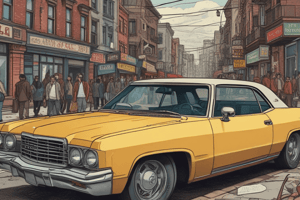Podcast
Questions and Answers
True or false:Biological determinism dominated criminology theorizing until the 1960s.
True or false:Biological determinism dominated criminology theorizing until the 1960s.
False (B)
True or false: Sociological explanations emerged in the 1920s.
True or false: Sociological explanations emerged in the 1920s.
False (B)
True or false: Strain perspective is not a sociological explanation of crime.
True or false: Strain perspective is not a sociological explanation of crime.
False (B)
True or false: Strain theory is a gender-based theory of crime.
True or false: Strain theory is a gender-based theory of crime.
True or false: General strain theory focuses on how positive emotions can lead to crime.
True or false: General strain theory focuses on how positive emotions can lead to crime.
True or false: Institutional anomie theory focuses on institutional power balance in society.
True or false: Institutional anomie theory focuses on institutional power balance in society.
True or false: Social disorganization perspective focuses on characteristics of individuals associated with high crime rates.
True or false: Social disorganization perspective focuses on characteristics of individuals associated with high crime rates.
True or false: Collective efficacy refers to individual residents' ability to act for the common good of the neighborhood.
True or false: Collective efficacy refers to individual residents' ability to act for the common good of the neighborhood.
True or false: Learning theories include classical conditioning, operant conditioning, and cognitive learning.
True or false: Learning theories include classical conditioning, operant conditioning, and cognitive learning.
True or false: Differential association and social learning theory are two major strain theories.
True or false: Differential association and social learning theory are two major strain theories.
True or false: Subcultural theories of juvenile delinquency neglect the role of police in targeting young working-class people.
True or false: Subcultural theories of juvenile delinquency neglect the role of police in targeting young working-class people.
True or false: Associations with delinquent friends are weak predictors of delinquent behavior.
True or false: Associations with delinquent friends are weak predictors of delinquent behavior.
Flashcards are hidden until you start studying
Study Notes
- Biological determinism dominated criminology theorizing until the Great Depression.
- Sociological explanations emerged in the 1930s.
- Strain perspective, social disorganization perspective, learning perspective, modern classical perspective, critical, conflict, and feminist perspective, and life-course perspective are sociological explanations.
- Strain theory by Robert Merton is a class-based theory of crime.
- General strain theory by Robert Agnew focuses on how negative emotions can lead to crime.
- Institutional anomie theory by Messner and Rosenfeld focuses on institutional power imbalance in society.
- Social disorganization perspective focuses on characteristics of environments associated with high crime rates.
- Collective efficacy by Sampson refers to cohesion among residents and their ability to act for the common good of the neighborhood.
- Learning theories include classical conditioning, operant conditioning, and social learning.
- Differential association by Sutherland and social learning theory by Akers are two major learning theories.
- The text discusses subcultural theories of juvenile delinquency.
- Cohen's Theory of Blocked Opportunity suggests that working-class youth turn to delinquent subcultures when they encounter blocked opportunities to achieve status and respect in conventional society.
- Miller's Theory of Focal Concerns suggests that lower-class values, such as trouble and toughness, are the cause of high delinquency.
- Cloward and Ohlin's theory suggests that people in the working class are often surrounded by criminal opportunities in the neighborhood, leading to the development of delinquent subcultures.
- Wolfgang and Ferracuti's Subculture of Violence theory suggests that there is a subculture among working-class Black males that promotes the use of violence.
- Anderson's Code of the Street theory suggests that there is a street subculture in Black, urban communities that places emphasis on respect and accepts violence as a way to stand up against disrespect.
- Hagan applied the idea of social embeddedness to criminology, arguing that people can be socially embedded in criminal networks.
- Critiques of subcultural theories include their limitations in explaining delinquent behavior in all working-class youth and their neglect of the role of police in targeting young working-class people.
- Definitions and differential reinforcement are important factors in delinquent behavior.
- Associations with delinquent friends are strong predictors of delinquent behavior.
Studying That Suits You
Use AI to generate personalized quizzes and flashcards to suit your learning preferences.




